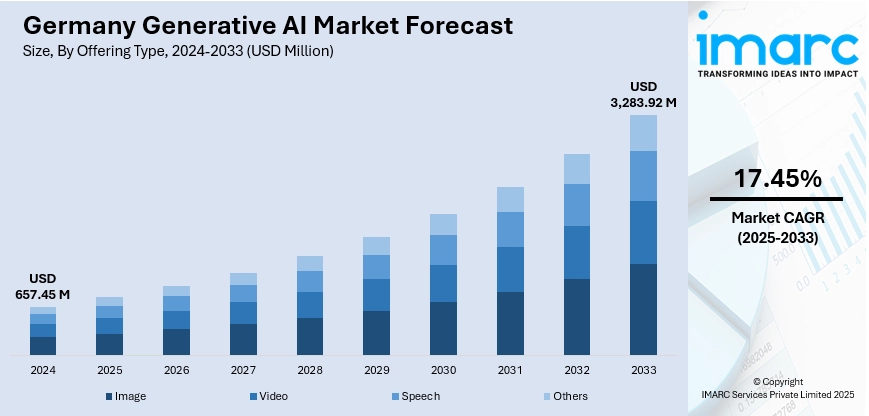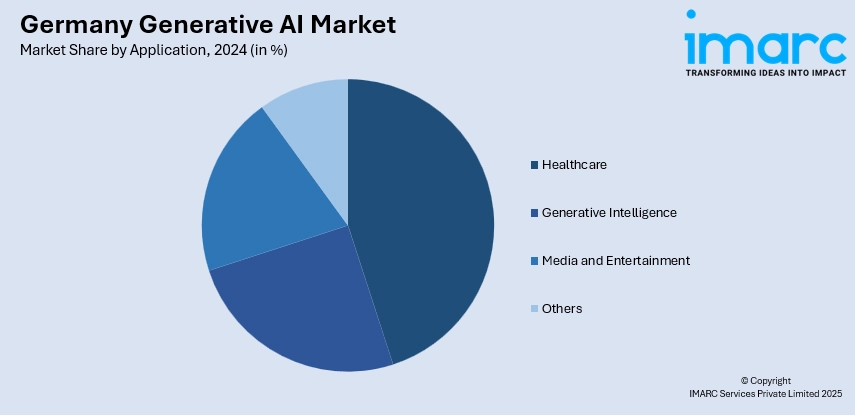
Germany Generative AI Market Size, Share, Trends and Forecast by Offering Type, Technology Type, Application, and Region, 2025-2033
Germany Generative AI Market Overview:
The Germany generative AI market size reached USD 657.45 Million in 2024. Looking forward, the market is expected to reach USD 3,283.92 Million by 2033, exhibiting a growth rate (CAGR) of 17.45% during 2025-2033. The market is driven by widespread adoption of generative AI in Germany’s industrial manufacturing sector for optimizing design and production. Healthcare and life sciences industries are utilizing AI-driven innovations to enhance diagnostics and drug development processes. Additionally, robust national policies, ethical frameworks, and active participation in EU-level AI governance are fostering responsible innovations, further augmenting the Germany generative AI market share.
|
Report Attribute
|
Key Statistics
|
|---|---|
|
Base Year
|
2024
|
|
Forecast Years
|
2025-2033
|
|
Historical Years
|
2019-2024
|
| Market Size in 2024 | USD 657.45 Million |
| Market Forecast in 2033 | USD 3,283.92 Million |
| Market Growth Rate 2025-2033 | 17.45% |
Germany Generative AI Market Trends:
Integration of Generative AI in the Manufacturing Sector
Germany’s leadership in advanced manufacturing and engineering creates a fertile environment for generative AI integration. Industrial firms are leveraging these technologies to optimize product design, streamline prototyping, and improve predictive maintenance strategies. Generative design algorithms are helping manufacturers create lightweight, cost-efficient components, particularly in sectors such as automotive, aerospace, and heavy machinery. Additionally, simulation-based generative tools support faster testing cycles, reducing development costs and timelines. Germany’s established industrial base and Industry 4.0 initiatives are encouraging collaborations between AI developers and manufacturers, accelerating generative technology adoption. On June 13, 2025, Deutsche Telekom and Nvidia announced a partnership to establish a generative AI cloud infrastructure in Germany, aimed at supporting European manufacturers, with 10,000 Nvidia GPUs to be integrated into Telekom's existing data centers. The German government plans to enable the acquisition of up to 100,000 GPUs, offering a 35% state subsidy, while the remaining 65% of the investment is expected from the private sector. This initiative aligns with the European Commission’s USD 20 billion funding plan for AI data center development. Educational institutions and technical universities are fostering joint research programs with private sector partners to advance domain-specific generative solutions tailored for German engineering standards. Furthermore, government funding through initiatives such as the “AI Made in Germany” strategy is helping SMEs access advanced AI tools. This confluence of digital manufacturing trends, technical expertise, and institutional backing forms a robust foundation for Germany generative AI market growth as industrial leaders embrace next-generation automation and innovation.

To get more information on this market, Request Sample
Policy Leadership and Ethical Frameworks for Responsible AI
Germany’s leadership in European technology policymaking is shaping the future of generative AI adoption through balanced regulatory and innovation strategies. As a prominent participant in the formulation of the EU AI Act, Germany is helping define responsible standards for generative models, emphasizing transparency, accountability, and ethical use. National initiatives, including the AI Action Plan, provide structured pathways for funding, research, and commercialization of generative technologies. For instance, on March 24, 2025, Siemens expanded its Industrial Copilot offering by launching a new generative AI-powered maintenance solution to enhance industrial operations across Germany and globally. The advanced system integrates with Senseye Predictive Maintenance, featuring two packages: Entry and Scale, aimed at reducing downtime and optimizing asset efficiency through AI-driven insights. With pilot programs already demonstrating a 25% reduction in reactive maintenance time, this innovation highlights Siemens’ commitment to advancing predictive maintenance. Germany’s public and private sectors are closely aligned in developing robust ethical guidelines for data handling, intellectual property rights, and mitigation of bias in AI-generated content. Universities and AI research institutes are conducting pioneering work on explainable AI (XAI) to foster trust in generative applications across industries. Furthermore, German think tanks and policy organizations are influencing international discussions around generative AI’s impact on society and the economy. This structured regulatory environment combined with active stakeholder engagement ensures that generative AI adoption in Germany aligns technological advancement with societal responsibility and European legal frameworks.
Germany Generative AI Market Segmentation:
IMARC Group provides an analysis of the key trends in each segment of the market, along with forecasts at the country and regional levels for 2025-2033. Our report has categorized the market based on offering type, technology type, and application.
Offering Type Insights:
- Image
- Video
- Speech
- Others
The report has provided a detailed breakup and analysis of the market based on the offering type. This includes image, video, speech, and others.
Technology Type Insights:
- Autoencoders
- Generative Adversarial Networks
- Others
The report has provided a detailed breakup and analysis of the market based on the technology type. This includes autoencoders, generative adversarial networks, and others.
Application Insights:

- Healthcare
- Generative Intelligence
- Media and Entertainment
- Others
The report has provided a detailed breakup and analysis of the market based on the application. This includes healthcare, generative intelligence, media and entertainment, and others.
Regional Insights:
- Western Germany
- Southern Germany
- Eastern Germany
- Northern Germany
The report has also provided a comprehensive analysis of all major regional markets. This includes Western Germany, Southern Germany, Eastern Germany, and Northern Germany.
Competitive Landscape:
The market research report has also provided a comprehensive analysis of the competitive landscape. Competitive analysis such as market structure, key player positioning, top winning strategies, competitive dashboard, and company evaluation quadrant has been covered in the report. Also, detailed profiles of all major companies have been provided.
Germany Generative AI Market News:
- On April 10, 2025, German AI startup Brain4Data partnered with Oracle to enhance its digital assistant, Fred, by integrating generative AI capabilities using Oracle Cloud Infrastructure (OCI) and Oracle Database 23ai. As a result of this collaboration, Fred can now answer over 80% of user queries with high accuracy while leveraging retrieval-augmented generation (RAG) for secure, context-rich responses using customer data.
- On October 24, 2024, DHL Supply Chain announced the implementation of generative AI tools to improve data management, customer support, and proposal accuracy, developed in collaboration with Boston Consulting Group (BCG). The initiative includes AI-driven data cleansing for logistics design, AI-assisted proposal generation for sales, and generative AI support in legal and customer service processes to boost operational efficiency. This development highlights the increasing integration of generative AI within Germany’s logistics sector.
Germany Generative AI Market Report Coverage:
| Report Features | Details |
|---|---|
| Base Year of the Analysis | 2024 |
| Historical Period | 2019-2024 |
| Forecast Period | 2025-2033 |
| Units | Million USD |
| Scope of the Report |
Exploration of Historical Trends and Market Outlook, Industry Catalysts and Challenges, Segment-Wise Historical and Future Market Assessment:
|
| Offering Types Covered | Image, Video, Speech, Others |
| Technology Types Covered | Autoencoders, Generative Adversarial Networks, Others |
| Applications Covered | Healthcare, Generative Intelligence, Media and Entertainment, Others |
| Regions Covered | Western Germany, Southern Germany, Eastern Germany, Northern Germany |
| Customization Scope | 10% Free Customization |
| Post-Sale Analyst Support | 10-12 Weeks |
| Delivery Format | PDF and Excel through Email (We can also provide the editable version of the report in PPT/Word format on special request) |
Key Questions Answered in This Report:
- How has the Germany generative AI market performed so far and how will it perform in the coming years?
- What is the breakup of the Germany generative AI market on the basis of offering type?
- What is the breakup of the Germany generative AI market on the basis of technology type?
- What is the breakup of the Germany generative AI market on the basis of application?
- What is the breakup of the Germany generative AI market on the basis of region?
- What are the various stages in the value chain of the Germany generative AI market?
- What are the key driving factors and challenges in the Germany generative AI market?
- What is the structure of the Germany generative AI market and who are the key players?
- What is the degree of competition in the Germany generative AI market?
Key Benefits for Stakeholders:
- IMARC’s industry report offers a comprehensive quantitative analysis of various market segments, historical and current market trends, market forecasts, and dynamics of the Germany generative AI market from 2019-2033.
- The research report provides the latest information on the market drivers, challenges, and opportunities in the Germany generative AI market.
- Porter's five forces analysis assist stakeholders in assessing the impact of new entrants, competitive rivalry, supplier power, buyer power, and the threat of substitution. It helps stakeholders to analyze the level of competition within the Germany generative AI industry and its attractiveness.
- Competitive landscape allows stakeholders to understand their competitive environment and provides an insight into the current positions of key players in the market.
Need more help?
- Speak to our experienced analysts for insights on the current market scenarios.
- Include additional segments and countries to customize the report as per your requirement.
- Gain an unparalleled competitive advantage in your domain by understanding how to utilize the report and positively impacting your operations and revenue.
- For further assistance, please connect with our analysts.
 Request Customization
Request Customization
 Speak to an Analyst
Speak to an Analyst
 Request Brochure
Request Brochure
 Inquire Before Buying
Inquire Before Buying




.webp)




.webp)












